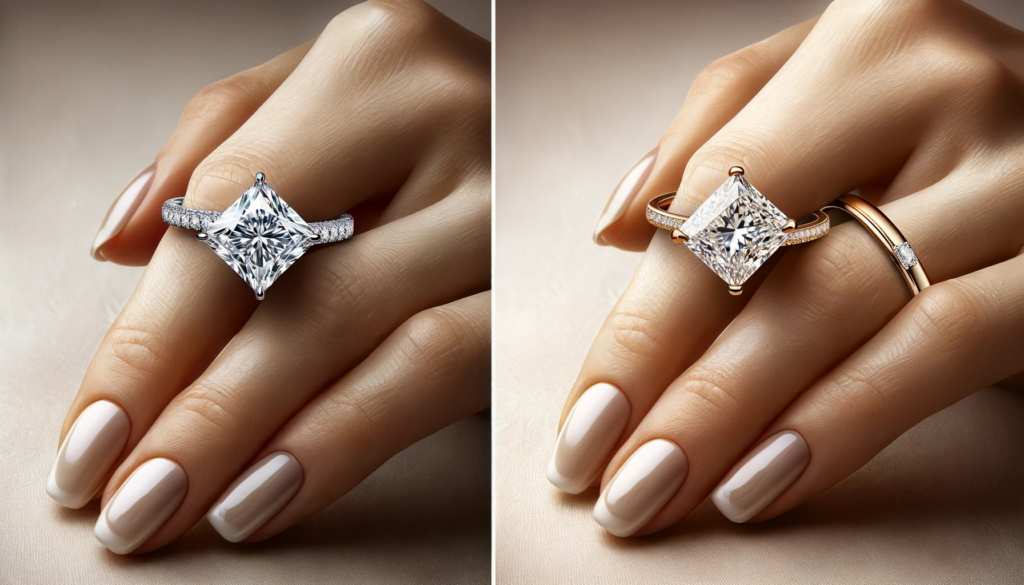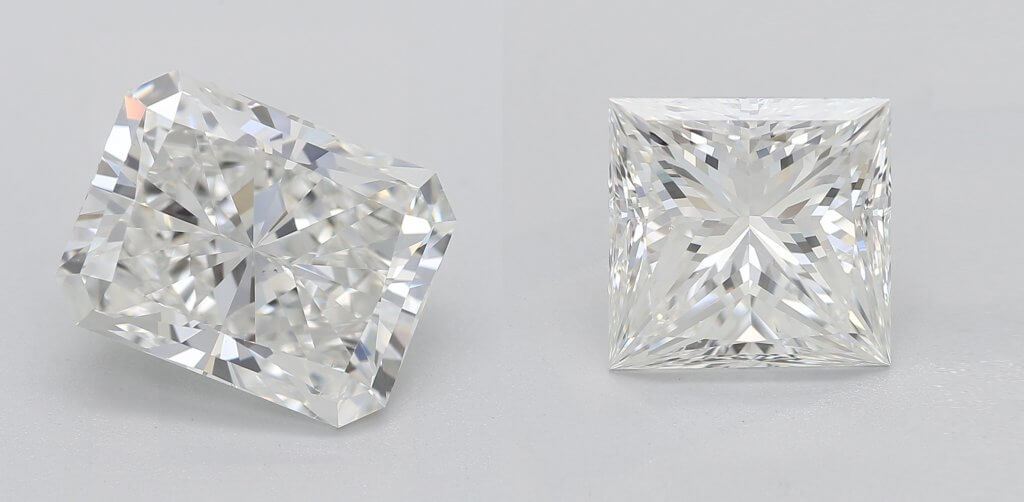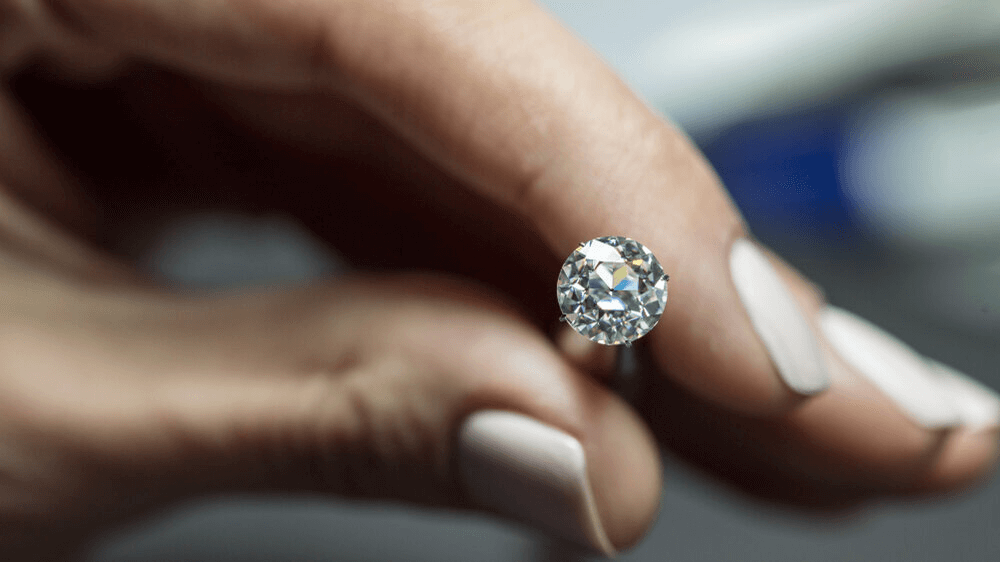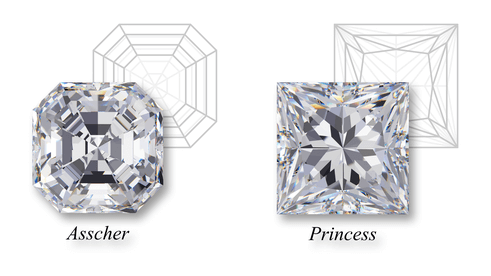Ultimate Diamond Faceoff: Radiant vs Princess

By Gary A.

Edited by Olivia H.
Published Oct 3, 2021
Edited on Mar 31, 2025
When it comes to choosing between the Radiant cut vs. Princess cut diamonds, is one truly more captivating, or is it all about your personal style?

- 7 Quick Tips for Choosing Between Radiant Cut and Princess Cut Diamonds for an Engagement Ring
- Introduction
- Understanding Modified Brilliants
- Understanding the Key Differences Between the Radiant and Princess Cuts
- Size and Appearance
- Light Performance (Sparkle)
- The Durability Advantage
- Cost Comparison
- Our Expert Take
- 7 FAQs
Before we dive deeper into the specifics, here are some practical tips to help guide your decision-making process:
7 Quick Tips for Choosing Between Radiant Cut and Princess Cut Diamonds for an Engagement Ring
- Tip 1: Understand the Shape and Appearance Radiant Cut: Recognize its elongated shape and cut corners that contribute to its durability and unique brilliance. The radiant cut often has a “crushed ice” appearance and is ideal for those who prefer a blend of the classic and contemporary. Princess Cut: Known for its sharp, square corners and more defined sparkle, the princess cut presents a traditional yet modern look. It’s crucial to understand that its sharp corners can be more prone to chipping, which leads to the next tip.
- Tip 2: Evaluate Durability and Setting: While the radiant cut is generally more durable due to its design, the princess cut requires careful consideration of the setting. Opt for settings that protect its corners, like a V-prong or bezel setting, to prevent chipping.
- Tip 3: Consider the Diamond’s Brilliance and Fire: The radiant cut is known for its brilliant sparkle and extensive fire, making it an excellent choice for maximum shine. Compare this with the princess cut, which also offers significant brilliance but with a different light reflection pattern.
- Tip 4: Factor In the Illusion of Size: Radiant cuts often give the illusion of a larger size due to their elongated shape, especially when compared to a princess cut of the same carat weight. Consider this aspect if size appearance is a priority.
- Tip 5: Analyze Color and Clarity Preferences: Both cuts can mask slight color and clarity imperfections, but this ability varies between the two. Radiant cuts, with their intense brilliance, can hide inclusions and color tints more effectively than princess cuts.
- Tip 6: Examine the Diamond Under Different Lighting: It’s essential to view both radiant and princess cut diamonds under various lighting conditions. This practice helps in understanding how each diamond interacts with light and reveals its unique characteristics.
- Tip 7: Reflect on Personal Style and Preference: Ultimately, the choice between a radiant and a princess cut diamond should align with personal style preferences. Some may prefer the traditional yet bold appearance of the princess cut, while others might lean towards the radiant cut for its unique blend of classic and modern facets.
Now that you’ve got these practical tips, use Jeweler AI below to find the perfect engagement ring that suits your style and budget:
Introduction
Offering a similar brilliance and fire top the Round, though in a more modern silhouette, these two shapes have long since been incredibly popular for engagement rings. Their similarities can, however, cause some shoppers to get confused between the two.
However, there are some noticeable differences between the Radiant and Princess cuts, and some subtler differences, too, that can help you decide between these two stunning shapes…

Understanding Modified Brilliants
This is a term used to describe diamond cuts that feature a facet pattern based on the one found in the Round Brilliant cut.
The Round cut is, of course, pretty much the archetype for diamond engagement rings – not least of all because of the unparalleled level of sparkle it offers. This sparkle is down to the particular facet pattern used to create the modern Round and, for that reason, has been modified into numerous other shapes with a view to retaining the same sparkle in new and interesting ways.
The Radiant and Princess cuts are just two of a number of modified brilliants, alongside the Pear, Oval, Marquise and Heart.
The best way to understand what makes a modified brilliant ‘brilliant’ is to compare the Round with a step cut, like the Emerald shape, which sparkles in a totally different way.
Understanding the Key Differences Between the Radiant and Princess Cuts
While both shapes feature a brilliant facet structure and geometric shape, their silhouettes, proportions, and effect within jewelry are totally different.
If you take a look at the side-by-side comparison of the Radiant and Princess cuts below, you’ll notice straight off the bat that the Radiant has twice as many sides as the princess. Its corners are ‘beveled’, creating a long, octagonal shape rather than a straightforward square or rectangle.
In actual fact, this serves to make the Radiant cut a little more durable than the Princess, since the sharply pointed corners of the Princess cut are vulnerable to damage – but we’re getting ahead of ourselves.
More often than not, the Radiant cut is rectangular in shape, with a silhouette that resembles the Emerald cut (although, of course, their facet patterns are total opposites). The Princess cut, however, is square.
Size and Appearance
A Radiant cut diamond can appear larger than a Princess cut of the exact same carat weight.
The elongated shape of the Radiant is pretty effective at giving the impression of having a higher carat weight, since its weight is distributed across the surface of the diamond, rather than within its pavilion.
The difference is pretty minor, but definitely noticeable when you’re comparing the two diamonds side by side.
Light Performance (Sparkle)
Both diamonds offer tremendous amounts of fire and brilliance, and both certainly rival the Round cut in terms of sparkle but, once again, the Radiant just has the edge over the Princess.
While the facet pattern of any modified brilliant cut is based on the arrangement found in the Round cut, each one is carried off a little differently due to differences in shape and proportion.
The table of the princess cut (that larger, flat surface at the center of the diamond) is larger than it is on the Radiant, meaning that, while this means extra light is able to get in, sparkle is also slightly diminished.
Don’t let that frighten you away from the romantic Princess, however. The difference in sparkle between a Radiant and a Princess is marginal, and both exemplify the power of the brilliant facet structure.
The Durability Advantage
The Radiant is more durable, as its corners are beveled.
This is something we touched on above, but which can sway some shoppers that bit further toward the Radiant cut.
Despite the fact that diamonds are incredibly strong and resilient things, the very fine, precise points that are so characteristic of the Princess cut are not impervious to chipping or breaking off if they are knocked hard enough. Obviously, during everyday wear, we can’t always protect against those little bumps.
This can be an issue when it comes to setting the diamond. Jewelers have to exercise incredible precision in order to ensure that the diamond is not only held securely in place by its prongs, and also that they are not exerting too much pressure on those delicate corners.

Cost Comparison
The Princess cut tends to be a more affordable choice, as it generates very little waste during the cutting process.
While the Princess cut remains a very popular choice among buyers, the most expensive diamond cuts tend to be those that are not only popular, but also require the diamond cutter to make some sacrifice with regards to the original size of the rough stone.
Creating a Princess diamond is a little more economical, in terms of the original stone, than cutting a Round – or even a Radiant cut. Diamond cutters can preserve more of the rough stone’s weight, which means that these diamonds are often a little more affordable.
The Radiant cut does, however, generally produce a pretty small amount of wastage too. It’s generally around 10% more expensive than the princess, but still a lot cheaper than the Round and Oval.
Our Expert Take
The Radiant certainly nabs top spot on a number of factors, but only just. Both of these shapes will create beautiful center stones for your engagement ring and, since the differences are mostly subtle, you should probably be led by your heart on this decision.
If you’re still 100% on the fence, then, by all means, lean toward the slightly more sparkly, slightly more durable, slightly larger-appearing Radiant. It creates truly striking and modern engagement rings, like this Radiant Cut Pave Ring, or even something as simple as this Radiant Cut Solitaire.
That said, if you and your bride-to-be feel inexplicably drawn toward the Princess cut, then there’s no use digging your heels into the dirt and opting for the Radiant instead. Our experienced jewelery maker, A.Jaffe, understands exactly how to protect those sharp corners from damage – and we’re willing to bet you won’t notice any significant difference in sparkle between the two.
On paper, the Radiant cut absolutely appears better than the Princess, but if all that theory goes out the window when you take a look at our jewelry store, then you know you’re onto a winner.
7 FAQs
- Q: What is the main difference between radiant and princess cut diamonds?
A: The main difference lies in their shape and facet structure. Radiant cuts have an elongated shape with cut corners and a “crushed ice” appearance, while princess cuts are more square or rectangular with sharp corners and a defined sparkle. - Q: Which diamond cut is more durable, radiant or princess?
A: Radiant cuts are generally more durable due to their cut corners, which are less prone to chipping compared to the sharp corners of the princess cut. - Q: Do radiant or princess cut diamonds appear larger?
A: Radiant cuts often appear larger because of their elongated shape and distribution of weight across the surface, giving the illusion of a bigger size compared to a princess cut of the same carat weight. - Q: Which cut offers more brilliance, radiant or princess?
A: Both cuts offer significant brilliance, but radiant cuts are known for a slightly higher degree of sparkle and fire due to their facet arrangement. - Q: Are radiant cut diamonds more expensive than princess cuts?
A: Typically, princess cuts are more economical due to less wastage in the cutting process. Radiant cuts can be slightly more expensive but are still less costly than some other diamond shapes like round brilliants. - Q: How does lighting affect the appearance of these diamond cuts?
A: Lighting can significantly impact how these diamonds display their brilliance and fire. It’s recommended to view them under different lighting conditions to appreciate their unique qualities. - Q: Can radiant and princess cut diamonds hide imperfections well?
A: Yes, both cuts can mask slight inclusions and color tints. However, the radiant cut, with its intense brilliance, can be more effective in hiding these imperfections compared to the princess cut.
Explore the brilliance of Radiant vs Princess cut diamonds with Jeweler AI – Your perfect ring is just a click away.
FOLLOW-UP GUIDE SERIES


























